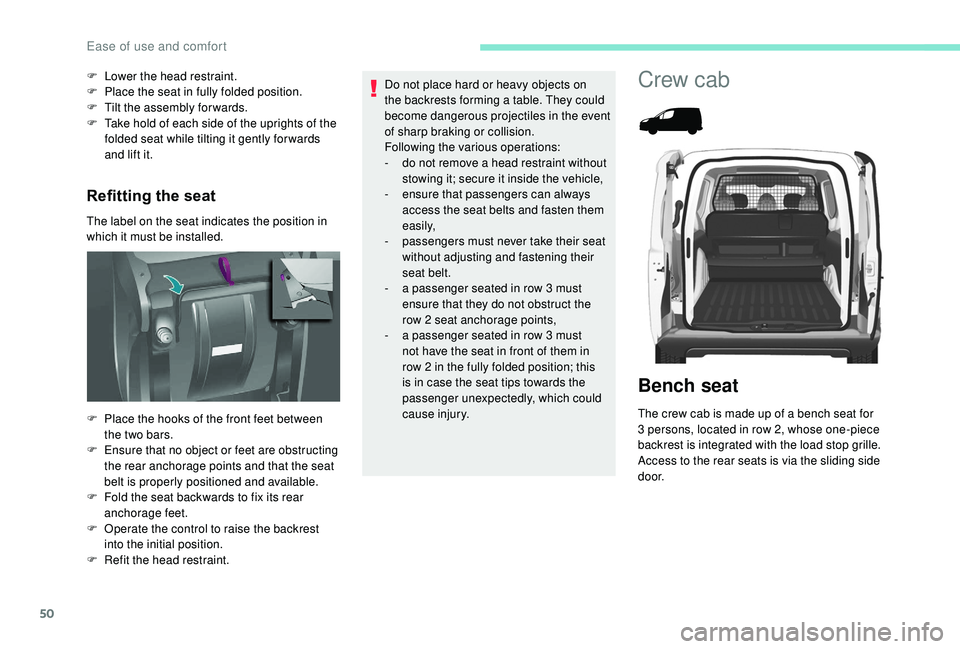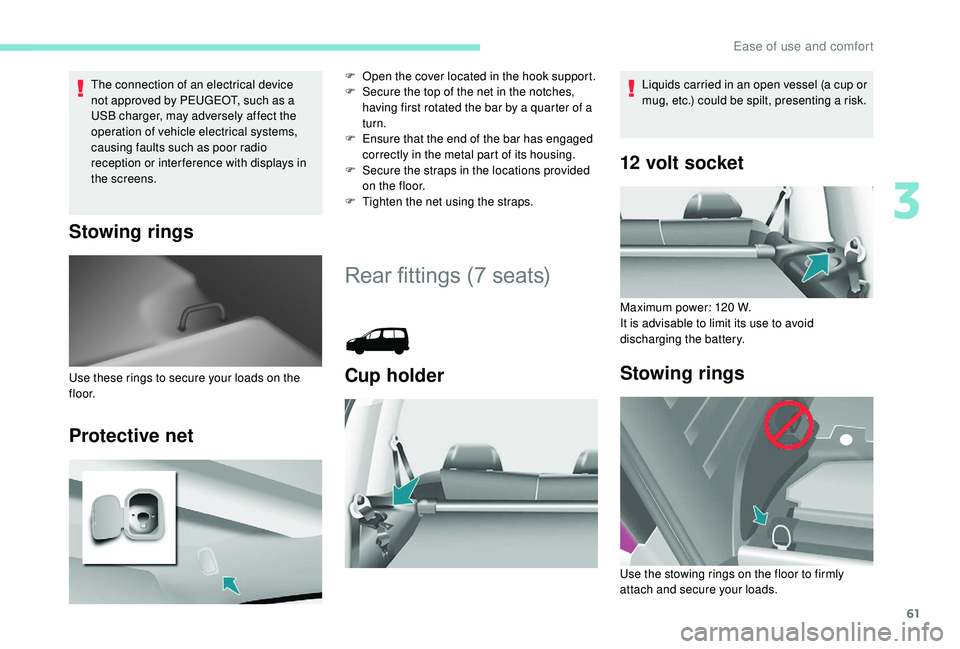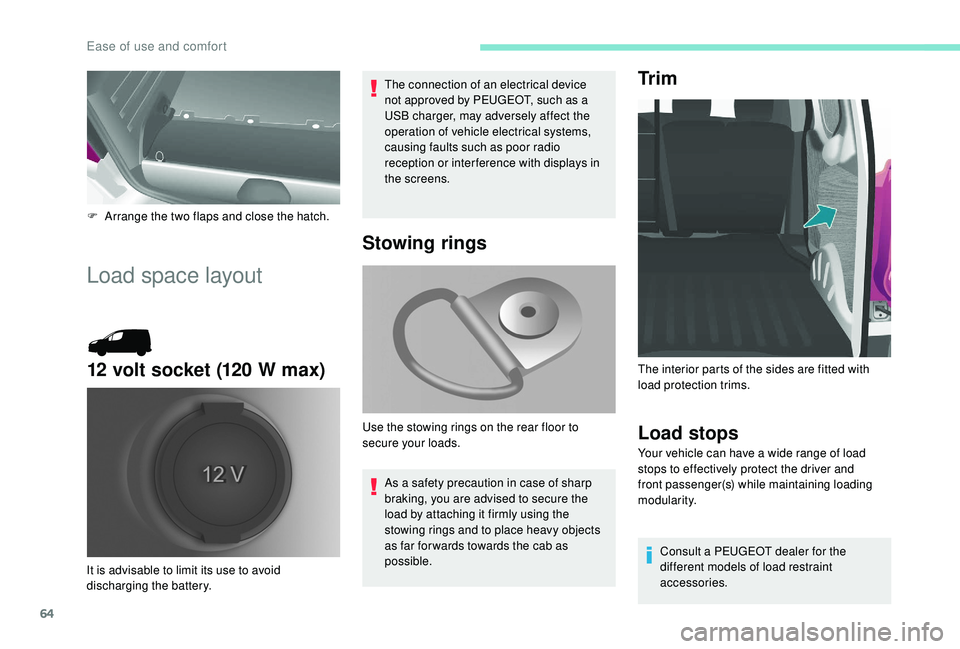Page 52 of 216

50
Refitting the seat
The label on the seat indicates the position in
which it must be installed. F
L
ower the head restraint.
F
P
lace the seat in fully folded position.
F
T
ilt the assembly forwards.
F
T
ake hold of each side of the uprights of the
folded seat while tilting it gently for wards
and lift it.
F
P
lace the hooks of the front feet between
the two bars.
F
E
nsure that no object or feet are obstructing
the rear anchorage points and that the seat
belt is properly positioned and available.
F
F
old the seat backwards to fix its rear
anchorage feet.
F
O
perate the control to raise the backrest
into the initial position.
F
R
efit the head restraint. Do not place hard or heavy objects on
the backrests forming a table. They could
become dangerous projectiles in the event
of sharp braking or collision.
Following the various operations:
-
d
o not remove a head restraint without
stowing it; secure it inside the vehicle,
-
e
nsure that passengers can always
access the seat belts and fasten them
easily,
-
p
assengers must never take their seat
without adjusting and fastening their
seat belt.
-
a p
assenger seated in row 3 must
ensure that they do not obstruct the
row 2 seat anchorage points,
-
a p
assenger seated in row 3 must
not have the seat in front of them in
row 2 in the fully folded position; this
is in case the seat tips towards the
passenger unexpectedly, which could
cause injury.
Crew cab
Bench seat
The crew cab is made up of a bench seat for
3 persons, located in row 2, whose one-piece
backrest is integrated with the load stop grille.
Access to the rear seats is via the sliding side
d o o r.
Ease of use and comfort
Page 54 of 216
52
Seat modularity and configurations
The various operations must be carried
out when stationary.
5-seat configuration
Head restraints and seat
belts
The three seats are equipped with seat belts
with inertia reels. The seat belts of the side
seats are secured on the panels, while the
seat belt of the central seat is secured on the
backrest of the bench seat.
Each seat has a head restraint, screwed to the
load stop grille, which can be removed.
Do not place a head restraint inside the
vehicle without stowing it or securing it to a
support.
Do not drive with rear passengers without
having the head restraints screwed in place.
There is no need to assist, guide or retain
it by the arm that remains free during the
tilting movement.
The rear seat belt fittings are not designed
to secure the load. Use only the stowing
rings on the floor.
The crew cab bench seat is not suitable
for the installation of a child seat.
Ease of use and comfort
Page 62 of 216
60
Rear fittings (5 seats)
Load space cover
To fold it
F Fold the half-shelf from the boot, lifting it up to release it from the catch C .
To remove it
To refit it
F Place the load space cover in front of A and B .F Push for ward to insert the lugs into the
catches.
F
U
nfold and clip into catches C .
To store it
(depending on version)
There is a space in the rear seat backrest to
accommodate the folded load space cover.
This rigid shelf conceals the items stored in the
boot.
F
F
old it.
F
R
elease it from catches A and B by pulling
towards you.
F
L
ift it up and remove the assembly.
When sharp deceleration occurs, objects
placed on the luggage cover can turn into
projectiles.
12 volt socket (120 W max)
F Slide it vertically between the side guides
located at mid-height of the backrests.
F
I
nsert the hinge first with the floating folds
facing upwards.
It is advisable to limit its use to avoid
discharging the battery.
Ease of use and comfort
Page 63 of 216

61
The connection of an electrical device
not approved by PEUGEOT, such as a
USB charger, may adversely affect the
operation of vehicle electrical systems,
causing faults such as poor radio
reception or inter ference with displays in
the screens.
Stowing rings
Protective net
F Open the cover located in the hook support.
F S ecure the top of the net in the notches,
having first rotated the bar by a quarter of a
turn.
F
E
nsure that the end of the bar has engaged
correctly in the metal part of its housing.
F
S
ecure the straps in the locations provided
on the floor.
F
T
ighten the net using the straps.
Rear fittings (7 seats)
Cup holderUse these rings to secure your loads on the
f l o o r.
12 volt socket
Maximum power: 120 W.
I t is advisable to limit its use to avoid
discharging the battery.
Stowing rings
Liquids carried in an open vessel (a cup or
mug, etc.) could be spilt, presenting a risk.
Use the stowing rings on the floor to firmly
attach and secure your loads.
3
Ease of use and comfort
Page 64 of 216
62
It is recommended that the load be
secured firmly using the stowing rings on
t h e f l o o r.
Storage hatches
The seat belt anchorages must not be used for
this purpose.
Roller-blind type load space cover
The load space cover is a roller-blind type
cover. Take care not to place heavy objects on
the load space cover when unreeled.
To install it
F Lift the corresponding hatch.The recess immediately next to the boot sill
is intended to accommodate the rolled tube
containing the load space cover.
F
P
ut the third row seats in the fully folded
position.
F
L
ift the storage hatch at the boot sill.
F
G
rab the blind in the middle and press it
against the left-hand pillar.
F
L
ift the assembly.F
P
osition the blind so that the rear load
space cover flaps are towards you.
F
E
ngage the left-hand lug of the blind in
bracket A .
Ease of use and comfort
Page 65 of 216
63
The blind has three flaps to conceal the
boot, whether the seats of the second row
are in the normal or comfort position.
Each flap has two clamps that snap to the
rods of each head restraint.
To remove it
F From the boot, pull the load space cover towards you to release it from the side
pillars.
F
C
ompress it, and then place the right-hand
lug facing bracket B .
F
R
elease to engage the blind in its bracket.
F
U
nroll the load space cover up to the rear
side pillars.
F
E
ngage the ends in the rear notches to keep
it taut. F
G
uide the load space cover as it reels in.
F
R
emove the clamps of the three flaps at the
rods of each second row head restraint.
To stow it
Stow it in the recess at the boot sill, the two
rear flaps upwards. F
C
ompress the blind to the left to remove it
from bracket B .
F
L
ift it up and pivot it for ward.
F
F
irst, compress the blind to the left.
F
Release.
3
Ease of use and comfort
Page 66 of 216

64
F Arrange the two flaps and close the hatch.
Load space layout
12 volt socket (120 W max)
The connection of an electrical device
not approved by PEUGEOT, such as a
USB charger, may adversely affect the
operation of vehicle electrical systems,
causing faults such as poor radio
reception or inter ference with displays in
the screens.
It is advisable to limit its use to avoid
discharging the battery.
Stowing rings
As a safety precaution in case of sharp
braking, you are advised to secure the
load by attaching it firmly using the
stowing rings and to place heavy objects
as far for wards towards the cab as
possible.
Use the stowing rings on the rear floor to
secure your loads.
Tr i m
Load stops
Your vehicle can have a wide range of load
stops to effectively protect the driver and
front passenger(s) while maintaining loading
modularity.
Consult a PEUGEOT dealer for the
different models of load restraint
accessories.
The interior parts of the sides are fitted with
load protection trims.
Ease of use and comfort
Page 67 of 216
65
BarsMid-height partition
Full glazed partitionPartition with flap
Removable flap
The flap located on the panelled section of
the mid-height partition, behind the passenger
seat(s), can be removed to enable long items to
be loaded.
F
T
urn the control at the top of the flap to
release it.
F
L
ift the flap to remove it from its housing.
F
R
otate the flap by 90° to the right.
F
S
tow it behind the driver’s seat, clipping it
into the attachment lugs.
3
Ease of use and comfort